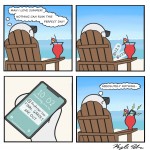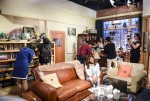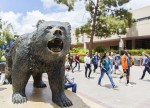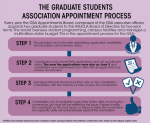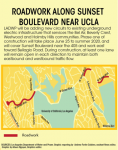Anderson Paak brings his Best Teef in the Game Tour to The Forum after the drop of his fourth studio album, “Ventura,” on April 12th.
Editorial Cartoon: Can’t catch a break
‘The Big Bang Theory’ sets take the stage on Warner Bros. tour after show’s end
This post was updated July 1 at 2:00 p.m.
New sets will arrive with a bang on the Warner Bros. Studio Tour Hollywood.
Beginning June 28, “The Big Bang Theory” stage, “Stage 25,” joined the company’s studio tour, allowing fans to experience backdrops like Apartment 4A and the California Institute of Technology Physics Department cafeteria.
Before the official opening of the “The Big Bang Theory” sets, a Q&A panel including cast members Wil Wheaton and Brian Thomas Smith alongside the show’s writer, creator and producers took place. The panel was a heartwarming reflection for the cast and producers as they answered questions about the show and reminisced about its final moments, said Steven Molaro, the show’s co-producer and writer.
“It was (an) emotional night last night. We shot our final episode of “Big Bang Theory” and as I was leaving, I took three pictures of my hand,” Molaro said. “The last one was on the plaque (of Stage 25), and I still get emotional thinking about it.”
The show created history on the Warner Bros. Studio lot as the country’s longest-running sitcom, spanned 12 seasons. And while the panel was filled with bittersweet nostalgia, co-producer and writer Steve Holland said it is touching to know the show has gained a large enough following that fans would want to visit and enjoy the sets. Ultimately, in preserving the sets, he said it’s as if the show never ended.
“It feels great to know that the people care enough they’re going to want to come to visit it, but also that we (the cast and crew) can stop by and visit it from time to time, too,” Holland said.
[RELATED: Mayim Bialik’s views on #MeToo movement demonstrates lack of Bruin values]
And although it has been hard for the cast to say goodbye, the set’s new role as a part of the tours will allow “The Big Bang Theory” to live on, allowing fans to experience the most prominent backdrops of the sitcom, such as Apartment 4A and the Caltech Physics Department cafeteria.
However, out of all the sets featured, Holland said he predicts that Sheldon’s seat on the brown leather couch will likely be the most visited spot on the tour.
“Everyone gets so excited to sit in Sheldon’s spot,” Holland said. “It’s been so sacred for so long, and now that everyone is going to be able to experience it, it’s going to be a well-worn spot.”
The overall condition of Apartment 4A remains pristine and kept exactly as one would see it on screen. From the books on the shelf to the mathematical formulas scribbled on whiteboards and even the Chinese takeout boxes on the coffee table, even the smallest details are in their rightful places.
Sitting directly opposite to Apartment 4A is Caltech’s cafeteria, which, although instantly familiar, was slightly underwhelming. The colors were not as vibrant in person and was small compared to what was featured on TV. Usually a friendly atmosphere on screen, the set was somewhat dull and less likely to capture the attention of attendees. Many attendees headed straight to Apartment 4A and Sheldon’s spot on the couch.
[RELATED: Recipients of The Big Bang Theory Scholarship bond with cast on set]
But perhaps the quirkiest set featured on the new studio tour is the elevator of the Pasadena apartment complex. Although this elevator was broken throughout the show’s entirety, it was the highlight of the Q&A, as Holland spent some time providing guests with stories of how actors would leave their chewing gum behind the elevator on the wall before entering set.
“In the hallway where the elevator is the bottom of the stairs, all the actors would stick their gum before this thing was started,” Holland said. “I’m not sure if they ever got preserved.”
The gum, unfortunately, did not make it into the studio tour. But what was obviously treasured throughout the evening was the love for the show shared between the cast, crew and fan base. And for a show whose creator and producer were terrified to go to their first Comic-Con in San Diego because they were afraid they would be facing an empty room, Chuck Lorre said everyone involved in the creation of “The Big Bang Theory” can relax knowing the history and culture of the show is not coming to an end quite yet.
“To know that the show has a life beyond our efforts is a terrific feeling,” Lorre said. “And it feels special … it’s quite a humbling experience.”
UCLA named a top-50 university globally in two recent rankings
UCLA was named among the world’s best universities for research and academia in two separate rankings last week.
Nature, a scientific journal, named all 10 of the UC’s campuses and its three affiliated national laboratories in the top 500 institutions that influenced research in natural sciences last year.
UCLA ranked 21st globally and eighth among national academic institutions.
Six other UCs ranked among the top 100 globally, with UC Berkeley at No. 14, UC San Diego at No. 22, UC San Francisco at No. 44, UC Santa Barbara at No. 61, UC Davis at No. 64 and UC Irvine at No. 72. Eight of the UCs were in the top 50 North American academic institutions.
UCLA ranked 35th globally in the QS World University Rankings, an annual list of the world’s top 1,000 undergraduate universities, tying with McGill University in Canada. The list was compiled by QS Quacquarelli Symonds, a global higher education company.
QS compiles its rankings by conducting a weighted assessment of six factors: research citations per faculty, faculty-to-student ratio, employer reputation, academic reputation, the ratio of international faculty and the ratio of international students. Eight of the UCs were listed this year.
Grad students allege student officials’ ASUCLA appointments improperly conducted
This post was updated July 2 at 9:35 p.m.
Graduate students raised concerns about the way student government officials conducted an appointment process for the Associated Students UCLA Board of Directors.
UCLA’s Graduate Students Association officials called an emergency forum during finals week to discuss the appointments process. The meeting was called in response to a petition signed by 31 graduate students that was submitted to the GSA vice president of internal affairs.
The GSA Appointments Board is a committee made up of four elected GSA officials and is responsible for appointing stipended graduate student representatives to GSA and UCLA boards and committees, such as the ASUCLA Board of Directors.
Every year GSA appoints two graduate students to the ASUCLA Board of Directors for two-year terms. Student representatives make up the majority of the board, which oversees a multimillion-dollar budget. They also receive one of the highest stipend amounts of any student representative position.
David Pederson, who applied to be an ASUCLA representative but did not receive the post, said he found some parts of the application review process troubling because he thinks the GSA Appointments Board did not comply with the GSA constitution.
The constitution states that all committee meetings must follow Robert’s Rules of Order and must keep written records. Robert’s Rules of Order are a set of guidelines for how to conduct meetings.
When Paul Kurek, another candidate who was not selected for the position, asked for these records, the Appointments Board said they had not followed those procedures, Pederson said.
Kurek did not respond in time for comment.
GSA President Zak Fisher said the Appointments Board has historically not operated with the same regulations as other committees because of the sensitive nature of the board’s duty, which includes evaluating individual candidates and their qualifications.
“The fact that it makes employment decisions, the fact that it has to talk about potential drawbacks and pros and cons of certain candidates’ profiles, and, as a candidate who has gone through this process before, I sort of assumed that’s not the sort of stuff I want people talking about in public,” Fisher said.
Fisher said he was told by the student union director, Roy Champawat, that the appointments should be made as soon as possible to allow for them to participate in an ASUCLA Board of Directors orientation retreat taking place June 14.
He said to accommodate this request, he set the application deadline for June 3 and planned to complete the appointments by June 10 – 12 days after GSA executive officers were sworn in.
However, the Appointments Board was unable to host interviews together or meet due to scheduling conflicts, so interviews were conducted by either one or two board members. Audio of interviews conducted by one member was shared among the board members, and discussion of candidates happened via phone calls or digital communication, Fisher said. Votes for the candidates also occurred through digital communication.
Proponents of the resolution discussed in June argued that the fact there was never a meeting in accordance with Robert’s Rules of Order inhibited the board’s ability to have a fair discussion about the candidates.
“If this is the way GSA is going to be appointing people to stipended positions and lots of other positions this year, that’s just a really bad sign,” Pederson said.
Paul Nesterenko, GSA vice president of internal affairs, said while the process happened quickly and the council was new to the process, he believes all candidates were treated fairly and with due process.
Nesterenko called the emergency meeting but was not in attendance. He said although he did not support the resolution, he called the meeting because it met the emergency forum requirements listed in the GSA codes.
The GSA codes state that an emergency forum can be called by two-tenths of one percent of the graduate students. The 31 signatures on the petition met the minimum requirement, which needed 28 graduate students in the 2018-2019 school year.
Nesterenko said he did not support the resolution because parts of the resolution’s description of the surrounding situation appeared to be based on hearsay. Additionally, he said he thinks the resolution, which calls for an impartial board to redo the process, is not correct since any issues with the appointment process would have to be resolved internally according to governing documents.
Fisher said he thinks the meeting was a waste of time and an inappropriate way to use the emergency meeting option, considering the meeting took place during finals week.
Ultimately, the emergency meeting did not have enough members in attendance to vote on the resolution. Any possibility of discussion depends on whether or not it is on the agenda for the first forum of fall quarter.
Pederson said he is exploring options to discuss the resolution in fall, such as asking Nesterenko, who is in charge of setting the GSA forum agenda, to put the resolution on the agenda or calling a special meeting during a forum break.
He said he thinks the issue of proper procedures goes beyond this particular appointment decision. Pederson added he wants to ensure that all future applicants for stipended and nonstipended positions receive due process.
Nesterenko said given the lack of support expressed by forum members who did attend the emergency meeting, and since the forum will have to ratify the appointments at the first forum of fall quarter anyway, he does not think he will put the resolution on the agenda in the future.
Fisher said for the sake of making the process more transparent, the Appointments Board plans on voting on candidates in a written space where all members are present and their votes are recorded. He added despite this modification, he does not think the original way in which the appointments were made was invalid.
Construction on Sunset Boulevard to cause lane closures for yearlong project
Yearlong roadwork on Sunset Boulevard near UCLA might cause travel delays to Westwood, according to a university announcement June 24.
Construction will occur on Sunset Boulevard between the 405 Freeway and Bellagio Road, and between South Beverly Glen Boulevard and Carolwood Drive.
Road crews will close portions of some lanes every weekday from 9 a.m. to 3:30 p.m. and Saturdays from 8 a.m. to 6 p.m., according to the Los Angeles Department of Water and Power. At least one lane will remain open in each direction for traffic.
The construction is part of an LADWP project to install additional power lines underground. The project began Tuesday and will continue until summer 2020.
UCLA said the roadwork might cause delays for patients, visitors and staff traveling to Ronald Reagan UCLA Medical Center and other UCLA Health facilities in Westwood. The university advised drivers to plan for extra travel time or consider alternate routes.
[RELATED: Metro Purple Line Extension construction to increase Westwood traffic]
Chang Gao, a graduate student in medicine who commutes to campus by way of Sunset Boulevard, said she thinks the lane closures have only delayed drivers a little.
“The traffic during summer is not as busy as usual,” Gao said. “We have to see how it goes when school begins.”
Animal-assisted therapy group supports students, UCLA Health patients and staff
Erin Rice once watched her therapy dog make a 6-year-old boy open his eyes, look at his mother and begin communicating after a surgery that removed one hemisphere of his brain.
“’This warm, fuzzy thing in his bed, this is what’s going to help him create those connections in his remaining hemisphere,’” Rice said a neurologist told her. “I changed my career for this kind of moment.”
Rice is the director of UCLA People-Animal Connection, a volunteer-run organization that connects trained dogs, and one miniature horse named Blue Moon, to students on campus and to patients and staff at UCLA Health centers.
PAC, founded in 1994, was one of the first animal-assisted therapy groups in the country and has been used as a model both nationally and internationally, Rice said.
“We get calls all the time from different hospitals and internationally on how to implement similar programs,” she said.
All PAC volunteers are vetted by Rice and her team. The dogs must be registered as therapy dogs and complete training and a six-to-eight-week orientation and probation period. The dogs and volunteers can only go out on visits twice a month.
Training therapy dogs includes obedience training, as well as training to help them acclimate to the hospital environment, said Jane Tomlinson, who has volunteered with PAC for 19 years.
Volunteers go through training as well, she added.
“You’re considered a team member,” Tomlinson said. “You’re evaluated as much as your dog.”
Rice said PAC currently has 75 teams of volunteers and dogs and is hoping to add another 25 teams in order to meet patient demand. In addition to bimonthly hospital visits, PAC participated in 80 special events this year at UCLA, she added.
The program hosts reoccurring events on campus such as UCLA Library’s Stressbusters program, in which PAC teams spend time with students in Powell Library during finals week. Last year, PAC dogs and volunteers also attended a UCLA basketball game, the UCLA Athletics Health and Wellness Fair, Nurses Week and Capus Health Mental Awareness Week.
Tomlinson has volunteered at UCLA with her dog Bubbles for the past five years, bringing the black Labrador retriever to events such as Powell Library Stressbusters and Alumni Day, she said. She added they also visit offices around campus to bring cheer to students and faculty.
“We love working with the students,” she said. “Every time I leave, they just can’t thank you enough.”
PAC also brings its volunteer teams to visit patients at Ronald Reagan UCLA Medical Center and Santa Monica UCLA Medical Center.
Mark Morocco, a UCLA emergency medicine physician who helps coordinate PAC visits to the emergency department, said the PAC program was founded by a cardiology nurse who noticed patients who had aquariums in their rooms had better outcomes following treatment.
He added there is significant statistical evidence supporting animal-assisted therapy.
“They did a study not long after the program was up and running,” he said. “Patients with visits from pet-assisted therapy had lower levels of adrenaline compounds, lower blood pressure and lower heart rates.”
Morocco said the dogs have a profound impact on the mentalities of both patients and hospital staff.
“A visit from a dog breaks the illusion of the hospital,” he said. “It makes the hospital feel less like a sterile, weird place. Modern hospitals, including ours, look kind of like a spaceship inside, and so PAC allows the patients to feel their humanity and these dogs have an effect that lasts for a couple of days.”
Another PAC program, “No One Dies Alone,” brings more specialized volunteer teams to the bedsides of patients judged to be entering the last 72 hours of their life.
“We have about 12 to 15 PAC teams that are additionally trained for these specialized visits as they’re more intense … we prepare for a lot of the deeper things that might come up, like feelings of their own mortality or feelings about a loved one that has passed,” Rice said.
She said that with the rise in opioid addiction rates, health professionals around the country and world have been searching for alternatives to prescription painkillers to provide patients pain relief, including programs such as PAC.
Therapy dogs work, Tomlinson said, because they provide nonjudgmental comfort and love.
“Many times I’ve gone to the room where the patient is depressed or they don’t want to move and the nurses can’t get them up,” she said. “And then here comes a dog, and sits on the bed, and before you know it – the warmth, the touch, the dogs don’t ask them questions, it’s unconditional love.”

